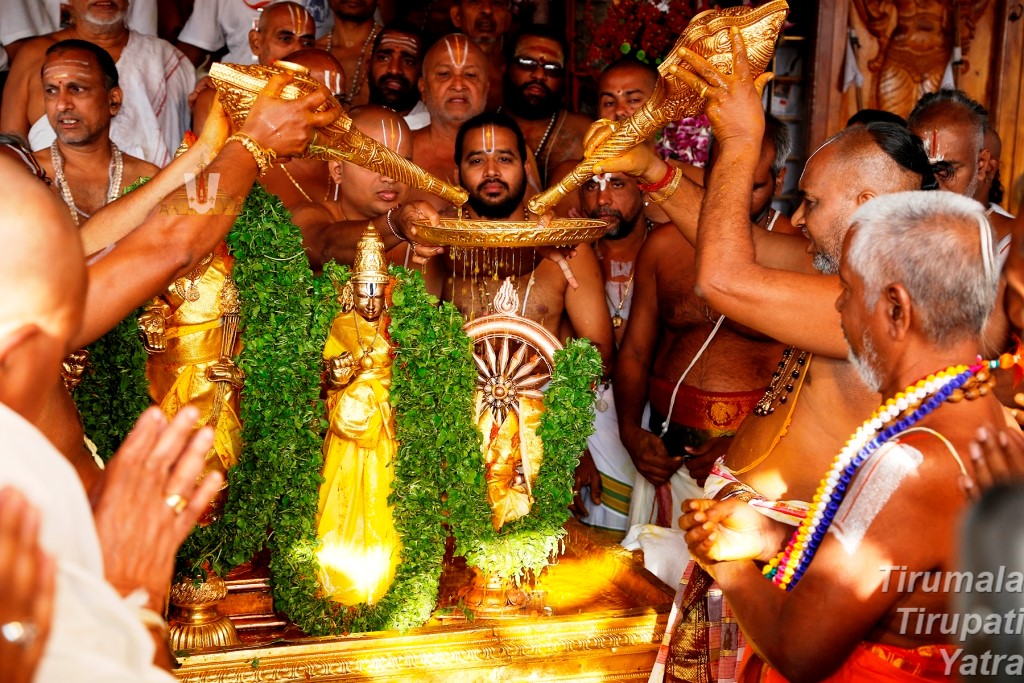A Ceremony of Purification: Unveiling the Significance of Tirumala Chakra Snanam .
For devotees embarking on a spiritual pilgrimage to Tirumala, Andhra Pradesh, witnessing the sacred ritual of Chakra Snanam is a deeply purifying experience. This unique ceremony, centered around the powerful symbol of the Sudarshana Chakra (disc), is believed to cleanse devotees of negativity and usher in a period of spiritual renewal. This comprehensive guide delves into the captivating essence of the Chakra Snanam, exploring its historical roots, symbolic meanings, and the unique experience it offers to pilgrims.

Table of Contents
A Ritual Steeped in Tradition: Unveiling the History of Chakra Snanam
The exact origins of the Chakra Snanam ritual remain unclear, but historical records suggest its practice in Tirumala for centuries. Legends associate the ceremony with Lord Vishnu’s (one of whose incarnations is believed to be Lord Venkateswara) cosmic dance during the churning of the celestial ocean. The Sudarshana Chakra is believed to have emerged from this churning, symbolizing the power of good to vanquish evil. The Chakra Snanam ritual is believed to harness this purifying power of the Sudarshana Chakra, cleansing devotees of negativity and paving the way for spiritual growth.
A Symbol of Purification and Renewal
The Sudarshana Chakra, a disc-shaped weapon wielded by Lord Vishnu, holds immense symbolic significance in Hinduism. The spinning disc represents the cyclical nature of life and the constant battle between good and evil. The Chakra Snanam ritual, where the Sudarshana Chakra is bathed in sacred waters, signifies the cleansing of negativity and the renewal of the divine weapon’s power. For devotees witnessing the ceremony, it serves as a reminder of the importance of inner purification and the need to shed negativity to achieve spiritual progress.
The meticulous attention to detail, the chanting of mantras, and the collective faith of the devotees all combine to create a captivating spectacle that transcends religious boundaries and evokes a sense of awe. It can be a bridge between cultures, fostering a sense of understanding and appreciation for the diverse ways people around the world seek purification and spiritual renewal.
Witnessing the Ritual: Unveiling the Steps of Chakra Snanam
The Chakra Snanam is a meticulous and symbolic ceremony performed annually during the Swathi Nakshatra in the month of Ashada (typically falls in June-July). Here’s a glimpse into the key aspects of this sacred ritual:
- Preparation and Significance of the Sacred Waters: In the days leading up to the Chakra Snanam, priests collect sacred water from various holy places, including rivers and temple springs. These waters are believed to be imbued with divine energy and hold the power to cleanse the Sudarshana Chakra. The specific selection of water sources adds to the symbolic significance of the ritual.
- The Bathing Ceremony: On the designated day, the Chakra Snanam takes place within the sanctum sanctorum of the Tirumala temple. Priests chant mantras and perform specific rituals to prepare the sacred waters. The Sudarshana Chakra is then meticulously bathed in these sacred waters, signifying its purification and renewal. The meticulous chanting and the focused attention of the priests create a sense of reverence and heighten the spiritual significance of the ceremony.
- Offerings and Prayers: Following the bathing of the Chakra, devotees outside the sanctum sanctorum offer prayers and devotional songs. Many also offer flowers, incense, and other symbolic offerings to seek blessings from the purified Sudarshana Chakra. The collective prayers and offerings create a powerful atmosphere of devotion and spiritual yearning.
- A Renewed Blessing: After the Chakra Snanam, the Sudarshana Chakra is believed to be imbued with renewed power. It is then displayed for a brief period, allowing devotees a glimpse of the purified weapon. This symbolic act signifies the culmination of the ritual and the availability of the Chakra’s protective power for devotees.
For devotees embarking on a spiritual pilgrimage to Tirumala, Andhra Pradesh, witnessing the sacred ritual of Chakra Snanam is a deeply purifying experience. This unique ceremony, centered around the powerful symbol of the Sudarshana Chakra (disc), is believed to cleanse devotees of negativity and usher in a period of spiritual renewal. This comprehensive guide delves into the captivating essence of the Chakra Snanam, exploring its historical roots, symbolic meanings, and the unique experience it offers to pilgrims.
A Ritual Steeped in Tradition: Unveiling the History of Chakra Snanam
The exact origins of the Chakra Snanam ritual remain unclear, but historical records suggest its practice in Tirumala for centuries. Legends associate the ceremony with Lord Vishnu’s (one of whose incarnations is believed to be Lord Venkateswara) cosmic dance during the churning of the celestial ocean. The Samudra Manthan, as it is known in Hindu mythology, narrates the churning of the cosmic ocean by Devas (celestial beings) and Asuras (demons) to obtain the Amrita (elixir of immortality). During this churning, various divine objects emerged, including the Sudarshana Chakra.
The Sudarshana Chakra is believed to have materialized from Lord Vishnu’s अंश ( अंsha, meaning “part”) and is wielded by him as a weapon to vanquish evil. The Chakra Snanam ritual is believed to harness this purifying power of the Sudarshana Chakra, cleansing devotees of negativity and paving the way for spiritual growth.
A Symbol of Purification and Renewal
The Sudarshana Chakra, a disc-shaped weapon wielded by Lord Vishnu, holds immense symbolic significance in Hinduism. The spinning disc represents the cyclical nature of life and the constant battle between good and evil. The Chakra Snanam ritual, where the Sudarshana Chakra is bathed in sacred waters, signifies the cleansing of negativity and the renewal of the divine weapon’s power. For devotees witnessing the ceremony, it serves as a reminder of the importance of inner purification and the need to shed negativity to achieve spiritual progress. The act of bathing the Chakra can be interpreted as a symbolic washing away of one’s own inner demons and imperfections, paving the way for a fresh start on the spiritual path.
The meticulous attention to detail, the chanting of mantras, and the collective faith of the devotees all combine to create a captivating spectacle that transcends religious boundaries and evokes a sense of awe. It can be a bridge between cultures, fostering a sense of understanding and appreciation for the diverse ways people around the world seek purification and spiritual renewal. Even for those unfamiliar with Hindu mythology, the ceremony’s focus on cleansing and renewal can resonate with a universal human desire for inner peace and a fresh start.
Witnessing the Ritual: Unveiling the Steps of Chakra Snanam
The Chakra Snanam is a meticulous and symbolic ceremony performed annually during the Swathi Nakshatra in the month of Ashada (typically falls in June-July). Here’s a glimpse into the key aspects of this sacred ritual:
- Preparation and Significance of the Sacred Waters: In the days leading up to the Chakra Snanam, priests undertake a meticulous selection process to gather sacred water from various holy places. These locations may include revered rivers like the Ganges and Yamuna, or prominent temple springs within the Tirumala complex itself. The specific selection of water sources adds to the symbolic significance of the ritual. The Ganges and Yamuna are considered sacred rivers in Hinduism, believed to possess the power to cleanse sins and purify the soul. Similarly, temple springs within the Tirumala complex are imbued with the sanctity of the temple itself, further enhancing the purifying properties of the water used in the Chakra Snanam.
- The Bathing Ceremony: On the designated day, the Chakra Snanam takes place within the sanctum sanctorum of the Tirumala temple. This innermost sanctum, also known as the Garbhagriha, is considered the most sacred area of the temple, housing the main idol of Lord Venkateswara. Access to the Garbhagriha is typically restricted to priests, but the sanctity of the location adds to the spiritual significance of the Chakra Snanam ceremony.
